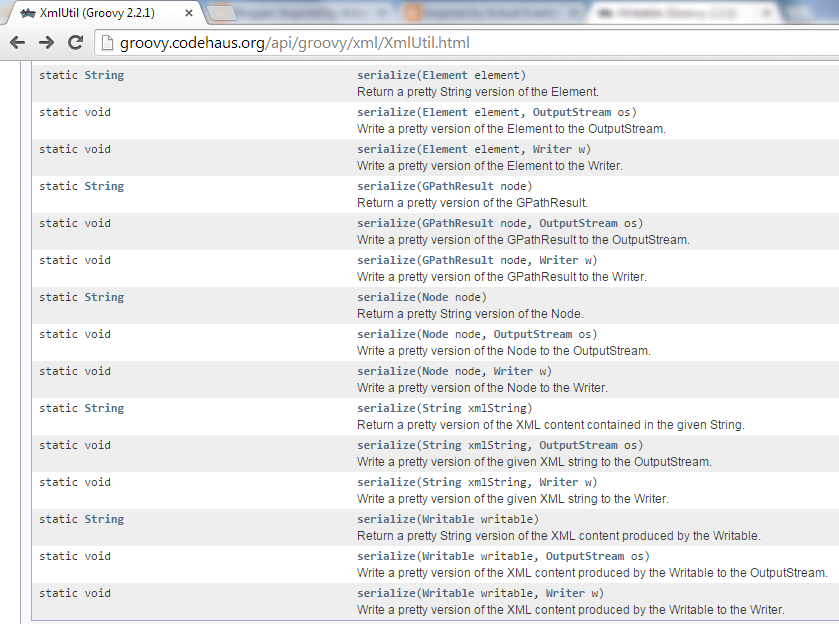Writing Groovy’s groovy.util.slurpersupport.GPathResult (XmlSlurper) Content as XML
In a previous blog post, I described using XmlNodePrinter to present XML parsed with XmlParser in a nice format to standard output, as a Java String, and in a new file. Because XmlNodePrinter works with groovy.util.Node instances, it works well with XmlParser, but doesn’t work so well with XmlSlurper because XmlSlurper deals with instances of groovy.util.slurpersupport.GPathResult rather than instances of groovy.util.Node. This post looks at how groovy.xml.XmlUtil can be used to present GPathResult objects that results from slurping XML to standard output, as a Java String, and to a new file.
This post’s first code listing demonstrates slurping XML with XmlSlurper and writing the slurped GPathResult to standard output using XmlUtil‘s serialize(GPathResult, OutputStream) method and the System.out handle.
slurpAndPrintXml.groovy : Writing XML to Standard Output
#!/usr/bin/env groovy
// slurpAndPrintXml.groovy
//
// Use Groovy's XmlSlurper to "slurp" provided XML file and use XmlUtil to write
// XML content out to standard output.
if (args.length < 1)
{
println "USAGE: groovy slurpAndPrint.xml <xmlFile>"
}
String xmlFileName = args[0]
xml = new XmlSlurper().parse(xmlFileName)
import groovy.xml.XmlUtil
XmlUtil xmlUtil = new XmlUtil()
xmlUtil.serialize(xml, System.out)The next code listing demonstrates use of XmlUtil‘s serialize(GPathResult) method to serialize the GPathResult to a Java String.
slurpAndSaveXml.groovy : Writing XML to Java String
#!/usr/bin/env groovy
// slurpXmlToString.groovy
//
// Use Groovy's XmlSlurper to "slurp" provided XML file and use XmlUtil to
// write the XML content to a String.
if (args.length < 1)
{
println "USAGE: groovy slurpAndPrint.xml <xmlFile>"
}
String xmlFileName = args[0]
xml = new XmlSlurper().parse(xmlFileName)
import groovy.xml.XmlUtil
XmlUtil xmlUtil = new XmlUtil()
String xmlString = xmlUtil.serialize(xml)
println "String:\n${xmlString}"The third code listing demonstrates use of XmlUtil‘s serialize(GPathResult, Writer) method to write the GPathResult representing the slurped XML to a file via a FileWriter instance.
slurpAndPrintXml.groovy : Writing XML to File
#!/usr/bin/env groovy
// slurpAndSaveXml.groovy
//
// Uses Groovy's XmlSlurper to "slurp" XML and then uses Groovy's XmlUtil
// to write slurped XML back out to a file with the provided name. The
// first argument this script expects is the path/name of the XML file to be
// slurped and the second argument expected by this script is the path/name of
// the file to which the XML should be saved/written.
if (args.length < 2)
{
println "USAGE: groovy slurpAndSaveXml.groovy <xmlFile> <outputFile>"
}
String xmlFileName = args[0]
String outputFileName = args[1]
xml = new XmlSlurper().parse(xmlFileName)
import groovy.xml.XmlUtil
XmlUtil xmlUtil = new XmlUtil()
xmlUtil.serialize(xml, new FileWriter(new File(outputFileName)))The examples in this post have demonstrated writing/serializing XML slurped into GPathResult objects through the use of XmlUtil methods. The XmlUtil class also provides methods for serializing the groovy.util.Node instances that XmlParser provides. The three methods accepting an instance of Node are similar to the three methods above for instances of GPathResult. Similarly, other methods of XmlUtil provide similar support for XML represented as instances of org.w3c.dom.Element, Java String, and groovy.lang.Writable.
The XmlNodePrinter class covered in my previous blog post can be used to serialize XmlParser‘s parsed XML represented as a Node. The XmlUtil class also can be used to serialize XmlParser‘s parsed XML represented as a Node but offers the additional advantage of being able to serialize XmlSlurper‘s slurped XML represented as a GPathResult.
| Reference: | Writing Groovy’s groovy.util.slurpersupport.GPathResult (XmlSlurper) Content as XML from our JCG partner Dustin Marx at the Inspired by Actual Events blog. |







